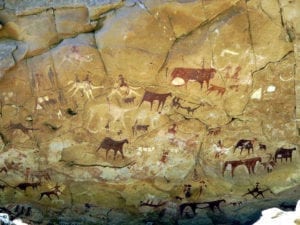Merle Borg
San Diego, California, United States
 |
| Prehistoric Rock Paintings at Manda Guéli Cave in the Ennedi Mountains – northeastern Chad. Photo by David Stanley. 2015. CC BY 2.0. |
It was an ordinary accident. Two boys driving to high school had topped a hill too fast, and wedged their small pickup under a stopped truck. Hundred-foot skid marks explained it all.
Both boys were pinned in the wreckage, legs folded in odd directions. The driver was convulsing thick blood. They struggled weakly, and while distant sirens found their way, the truck driver readied a fire extinguisher and I held them still.
A woman was on the rescue team and I was thankful, yet vaguely uncomfortable with her stern competence. The men could remember the pounding rush, the feeling of supreme invincibility of their own youth; and with a certain resigned acceptance carried off two of their own. But the woman was an outsider at this humbling ritual; an intrusion of sanity, like a nun at a prizefight. I wondered if she understood the ancient instructions these boys were following when they raced along that narrow hilly road.
It was evening before I learned any more. Among the injuries were collapsed lungs, a fractured skull, and several broken legs, but both boys would survive. Horror turned to relief, then sadness.
Mother Nature has played a particularly cruel trick on the male of our species. We are unable to understand danger at adolescence, and are compelled to challenge it. These invincible young warrior instincts come from our tribal past and the combination creates a deadly rite of passage. Those of us who survived, boast of the things we did. The concept of danger cannot be communicated to young males; in the course of human evolution they were needed in this way.
We evolved as a clan or tribal species. As fire and tools were mastered, our problems with food and predators were largely overcome. As populations approached the limits of the hunting, scavenging, and gathering resources, conflicts arose. Warriors became necessary; a duty that involved dodging spears. Speed and agility were favored over size and strength.
Older members with hungry families would have had compelling reasons to lead in these risky confrontations, but they were slow, and were needed for their knowledge and experience. Young females were swift and agile, but they were necessary for reproduction. Young males were the obvious front rank candidates, but in nature this is backwards. The young do not risk their lives for the old. It is not a natural response. Getting these warriors out front presented a problem.
Famous for her tricks, Mother Nature found a way. She gave young males a love for thrills and glory, and the belief that they were invincible. Then, for good measure, she gave everyone a love for “heroes.” It was a costly solution but it worked. Groups armed with these willing weapons prevailed. For uncounted eons we males have been bred to be thrillingly, usefully, and expendably stupid at adolescence. Like temporary soldier ants, we were not designed to survive; we were designed so the rest would.
The traits remain but the world has changed. The grisly result pours into emergency rooms daily, not all of it extracted from mangled vehicles. In some areas, teams of idle boys engage in a rivalry that involves shooting at each other. Different game. Same thrills. Same glory. Same sirens. Same angry words scrawled on the toe tags: “terminal stupidity.”
The spears are gone but the tricks live on. Ages of tribal “push and shove” have left the intelligent species with a fearsome “we/they” mentality, and sons that are dumber than dirt.
For most of human history, warriors were revered. Young men knew their purpose, and strutted in noble importance. In today’s placid world, they languish in boredom. The tedium can reach critical mass; and when a chance for thrills and glory arises, young men heed the ancient call.
Boys in the U.S. between the ages of fourteen and twenty-six die of injuries at a rate three-and-a-half times that of the more sensible sex.1 The loss is particularly disturbing, because the last few generations of us have known about our ancestry, yet we have refused to accept our heritage and explain it to our children.
Anthropologists try. They lead us to excavations and point eagerly at our origins. We glance impatiently at some crumbling bones and primitive weapons, then look back at our shiny things and walk away. We dismiss our parentage and let Luck decide which of our sons will live.
The boys on that road needed to know what they were passing through. Fitted with obsolete instructions and set loose in a modern arena, they are between a world that is no more and a world they are not ready for. They should be told about their dangerous inheritance. Pitted against breeding, knowledge is sorrowfully inadequate, but instincts, like tricks, lose much of their terrible power once revealed. Clear and understandable information is all we can give them, and we owe them that much.
References
- Centers for Disease Control and Prevention http://webapp.cdc.gov/sasweb/ncipc/mortrate.html Annual injury deaths, all intents, 1999-2017, ages 14-26, (Female – 24.24/100,000 — Male – 84.17/100,000).
MERLE BORG is a retired architect and builder living in California. As a father and grandfather with a good memory for the stupid things they have done, or that he himself fantasized about in his youth, he believes our sons are owed the darker side of human history. It could help keep them alive.
Spring 2019 | Sections | Personal Narratives

Leave a Reply